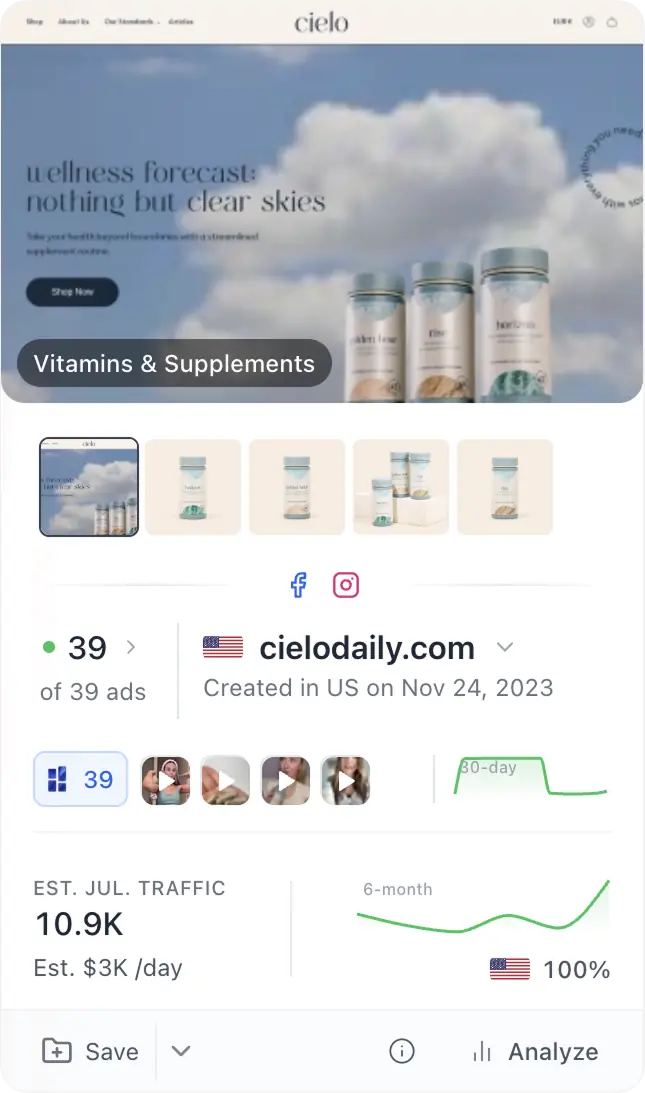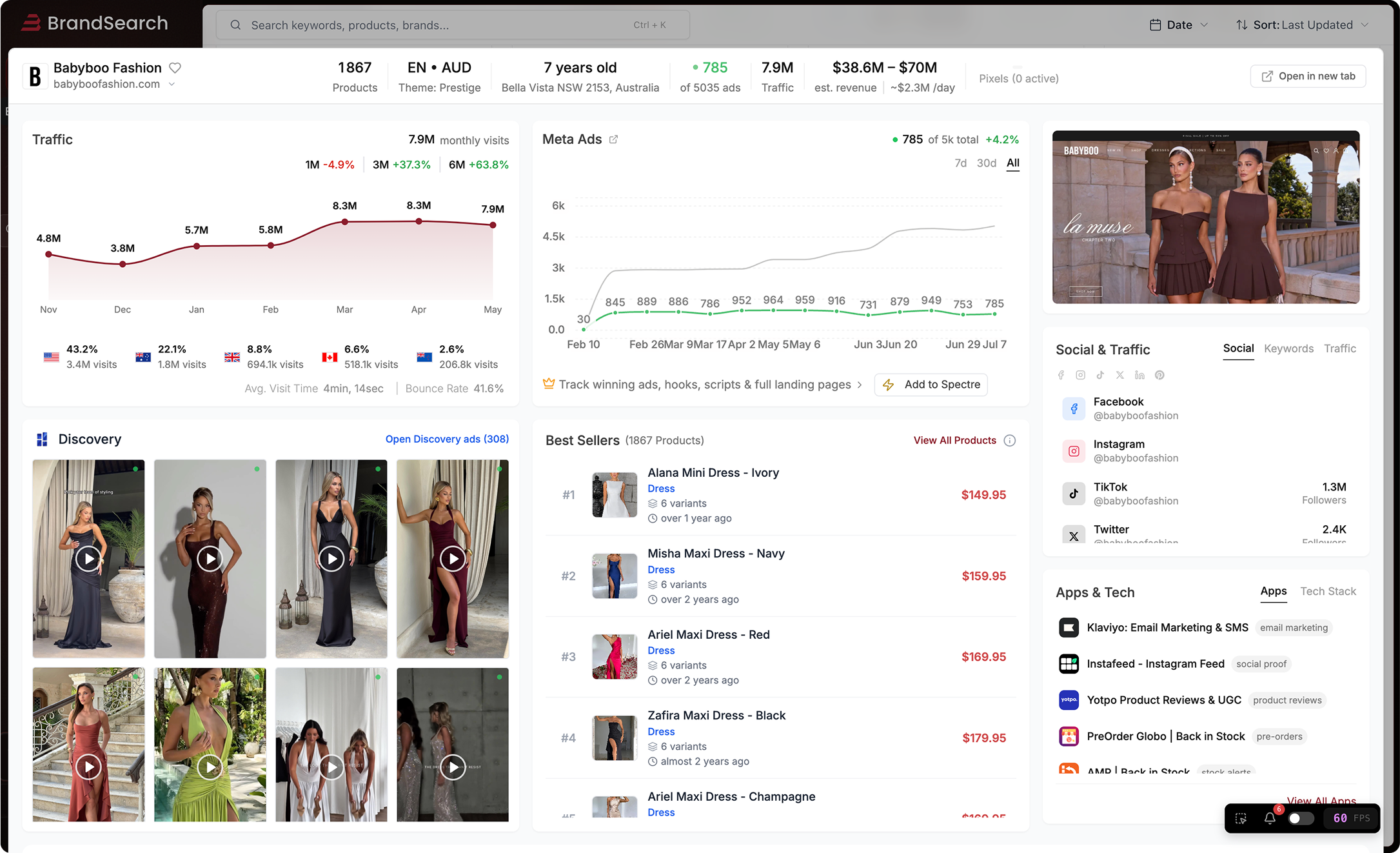In today's competitive e-commerce landscape, having access to comprehensive store intelligence is crucial for success. Whether you're looking to analyze competitors, discover emerging trends, or identify market opportunities, the ability to search and filter through millions of Shopify stores provides an unparalleled competitive advantage.
This comprehensive guide will show you how to access and analyze over 3.1 million Shopify stores using advanced filtering criteria including traffic patterns, Meta advertising data, scaling indicators, technology stacks, and more.
Access 3.1M+ Shopify Stores Database
The most comprehensive Shopify store database available today contains over 3.1 million active Shopify stores from around the world. This massive database includes everything from emerging startups to established 8-figure brands, giving you unprecedented access to the entire Shopify ecosystem.
Unlike other platforms that only track a few thousand stores, this complete database is updated in real-time, ensuring you're always working with the most current information. You can explore stores across every industry, niche, and geographic location to identify trends, opportunities, and successful business models.
This comprehensive coverage means you'll never miss a potential competitor, trending brand, or emerging market opportunity. Whether you're looking for established brands to benchmark against or new players disrupting traditional markets, you'll find them all in this extensive database.
Filter by Traffic and Performance Metrics
One of the most powerful features for analyzing Shopify stores is the ability to filter by traffic metrics and performance indicators. You can sort stores by monthly visitors, traffic growth patterns, bounce rates, and session duration to identify which brands are truly performing well.
Traffic filtering helps you discover stores that are scaling rapidly or maintaining consistent growth over time. You can identify seasonal patterns, spot emerging trends, and find stores that are successfully driving organic or paid traffic to their sites.
Advanced traffic analytics also reveal geographic traffic sources, helping you understand which markets are driving the most engagement for specific store types. This insight is invaluable for planning your own geographic expansion or identifying underserved markets with high potential.
Track Meta Ads Count and Advertising Strategies
Meta (Facebook and Instagram) advertising data provides crucial insights into which stores are actively scaling and investing in paid growth. By filtering stores based on their Meta ads count, you can identify brands that are aggressively acquiring customers and scaling their operations.
Stores running hundreds or thousands of Meta ads typically indicate successful brands with proven products and sustainable business models. These high-ad-count stores often represent the best opportunities for competitive analysis and strategy replication.
You can also track ad trends over time to see which stores are increasing their advertising spend (indicating growth) or reducing it (potentially indicating challenges). This real-time advertising intelligence helps you spot opportunities before they become obvious to everyone else in your market.
Identify Scaling Patterns and Growth Indicators
Understanding which stores are actively scaling versus those that are declining is crucial for competitive intelligence. Advanced filtering allows you to identify stores based on growth patterns, revenue trends, and scaling indicators like employee count increases or geographic expansion.
Scaling patterns reveal which business models and product categories are currently experiencing the most growth. You can filter for stores that have recently expanded their product lines, entered new markets, or significantly increased their advertising spend.
These growth indicators help you identify not just what's working now, but what's likely to continue working in the future. By analyzing scaling patterns, you can make more informed decisions about which opportunities to pursue and which trends to follow.
Analyze Apps, Themes, and Technology Stack
Every Shopify store's technology stack tells a story about their strategy, budget, and focus areas. By filtering stores based on their installed apps, themes, and technology choices, you can uncover valuable insights about successful store operations.
App analysis reveals which tools successful stores are using for email marketing, customer service, inventory management, and conversion optimization. Stores using premium apps often indicate higher revenue and more sophisticated operations.
Theme analysis helps you understand design trends and identify which themes are associated with high-performing stores. You can discover whether successful stores in your niche prefer custom themes or specific paid themes, and what design elements they prioritize for conversion optimization.
Premium Pixels and Analytics Tracking
Advanced tracking pixels like TripleWhale, Hyros, Northbeam, and others indicate stores that are serious about data-driven growth and have the budget for premium analytics tools. Filtering by these premium pixels helps you identify sophisticated operators who understand the importance of accurate attribution.
Stores using premium pixels typically represent higher-revenue businesses that have moved beyond basic analytics to advanced attribution modeling. These stores often have more refined customer acquisition strategies and better understanding of their unit economics.
Premium pixel usage also indicates stores that are likely running complex, multi-channel marketing campaigns and have the technical sophistication to optimize based on detailed attribution data. These insights help you identify the most advanced competitors in your space.
Find New Stores and Emerging Opportunities
While established stores provide valuable benchmarking opportunities, newly launched stores can reveal emerging trends and untapped market opportunities. Filtering for recently created stores helps you spot new entrants before they become mainstream.
New store analysis reveals which product categories are attracting fresh investment and entrepreneurial interest. You can identify emerging niches, new product innovations, and shifts in consumer demand by monitoring what types of stores are being launched.
Early identification of successful new stores gives you a competitive advantage in spotting trends before they become saturated. You can analyze their initial strategies, product positioning, and marketing approaches to inform your own launch or expansion strategies.
Advanced Search and Discovery Methods
Beyond basic filtering, advanced search capabilities allow you to find stores using keyword searches, product categories, geographic targeting, and even reverse domain lookups. These sophisticated search methods help you uncover stores you might never find through traditional browsing.
Keyword searching enables you to find all stores selling specific products or targeting particular customer segments. You can search for stores by product names, brand descriptions, or even marketing copy to identify direct and indirect competitors.
Geographic and demographic targeting helps you find stores serving specific markets or customer segments. This is particularly valuable for market entry research or identifying stores that successfully serve similar audiences to your target market.
Start Your Store Research Today
Access to comprehensive Shopify store data transforms how you approach competitive research, market analysis, and opportunity identification. With over 3.1 million stores at your fingertips and advanced filtering capabilities, you can uncover insights that would be impossible to find through manual research.
The ability to filter by traffic, Meta ads count, scaling patterns, technology stacks, and premium pixels gives you unprecedented visibility into what's working in the e-commerce world. Whether you're looking for established brands to benchmark against or emerging opportunities to capitalize on, this comprehensive database provides the intelligence you need to make informed decisions.
Start leveraging this powerful store intelligence today to gain the competitive edge your business needs to scale successfully in the crowded e-commerce marketplace.

